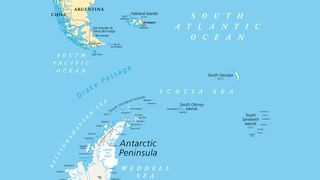Have you ever stumbled upon viral videos showcasing a stark line in the ocean, with seemingly distinct bodies of water refusing to blend? These intriguing visuals often claim to depict the unmixable boundary between the Pacific and Atlantic Oceans, suggesting these vast water bodies remain stubbornly separate. But is there truth to these claims, or are we witnessing an oceanographic illusion?
The notion that the Atlantic and Pacific Oceans remain separate is a captivating myth, but reality paints a different picture. The truth, as oceanographer Nadín Ramírez from the University of Concepción in Chile explains, is a resounding “yes, they absolutely mix!” While dramatic lines in the ocean can appear, they don’t signify an impassable barrier between these oceans. Instead, they represent areas where waters with differing properties – temperature, salinity, or density – meet and gradually blend. Think of it like adding cream to your coffee; mixing happens, but it takes time for the swirl to fully disappear.
Debunking the Myth: Oceans are Constant Mixers
The viral videos often misinterpret natural phenomena. These visible lines are typically found where freshwater sources, like rivers or melting glaciers, flow into the ocean. The difference in density and salinity between freshwater and saltwater creates a temporary visual boundary. However, to suggest this means the Pacific and Atlantic are fundamentally separate is a misconception.
Just as stirring your coffee speeds up the cream’s dissolving process, various forces in the ocean facilitate the mixing of waters from different origins. Powerful winds, robust waves, and dynamic ocean currents act as the ocean’s stirrers, ensuring that the waters of the Atlantic and Pacific are in constant flux and intermingling.
Key Mixing Zones: Strait of Magellan and Drake Passage
The region near the southern tip of South America is a prime location where the Pacific and Atlantic Oceans converge. Here, the landmass breaks into a series of islands, creating channels and passages where ocean mixing is readily observable, albeit in different forms.
One notable waterway is the Strait of Magellan. Within its sheltered waters, meltwater from glaciers flows into the sea, creating noticeable lines where freshwater meets the more saline ocean water. These lines, while visually similar to those in viral videos, are localized effects and not boundaries separating entire oceans.
 Map highlighting the Drake Passage, the area where the Atlantic and Pacific Oceans meet and vigorously mix due to strong currents and turbulence.
Map highlighting the Drake Passage, the area where the Atlantic and Pacific Oceans meet and vigorously mix due to strong currents and turbulence.
Further south, the Drake Passage, located between South America and Antarctica, presents a dramatically different mixing environment. This open ocean gateway is notorious for its turbulent conditions. Characterized by powerful currents and colossal waves, some reaching heights of 60 feet (18 meters), the Drake Passage is a highly effective natural mixer. According to Ramírez, these energetic conditions “improve the mix” between the Pacific and Atlantic waters significantly.
The Role of Ocean Currents and Tides in Mixing
Ocean mixing isn’t limited to surface turbulence. Deep within the ocean, tides play a crucial role. As tides ebb and flow, they drag water across the uneven seafloor, generating turbulence even in the ocean depths. Casimir de Lavergne, a researcher at Sorbonne University and the French National Center for Scientific Research (CNRS), highlights this process as a significant contributor to ocean mixing.
Furthermore, global ocean currents act as vast conveyor belts, constantly moving water around the planet. The Antarctic Circumpolar Current, a powerful current in the Southern Ocean, pulls water from the Pacific into the Atlantic through the Drake Passage. Simultaneously, other currents transport Pacific water around the tip of South Africa, feeding it into the Atlantic from the east. These currents ensure a continuous exchange of water masses between the oceans.
Layers and Mixing Rates: Not All Mixing is Equal
While oceans are constantly mixing, it’s important to understand that this process isn’t uniform. Oceanographer Ramírez uses the analogy of a layered cake to describe the ocean’s structure. Water masses with distinct properties, known as “clines,” form layers based on their origin and characteristics.
Mixing occurs more readily at the surface, influenced by wind and waves, and near the seafloor, due to tidal turbulence. However, in the mid-layers of the ocean, away from these turbulent zones, mixing happens more slowly. This is because there is less energy to drive the blending of different water layers.
Oceanographers also distinguish between “mixing” and “exchanging” water. Mixing, in the scientific sense, implies an irreversible transformation of water properties, like cream fully dissolving into coffee. Exchanging, on the other hand, refers to the movement of water masses without complete property blending. The global currents facilitate a constant exchange of water between the Pacific and Atlantic, even if complete mixing of all properties takes time.
Climate Change and the Future of Ocean Mixing
The intricate dance of ocean mixing is not immune to the effects of climate change. Research indicates that human-induced climate change is already impacting ocean currents and potentially slowing down mixing rates.
As polar ice melts, it introduces a surge of freshwater into the oceans. This influx of less dense freshwater increases the density difference between surface and deep waters, making it harder for them to mix. De Lavergne notes that this increasing density difference and the slowing of currents are expected to alter how oceans circulate oxygen and nutrients, with potential consequences for marine ecosystems.
Despite these changes, the fundamental truth remains: the Atlantic and Pacific Oceans are interconnected and constantly mixing. As long as winds blow and tides flow, these vital processes will continue to shape our oceans, ensuring they remain dynamic and interconnected bodies of water.
